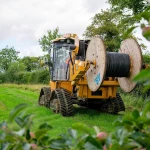Vodafone Improves UK 4G and 5G Mobile Coverage via Manholes
Most of the time when a mobile operator wants to improve their network coverage then they install new base stations or small cells in high locations, such as on top of a building, mast or street light. Now Vodafone has decided to go in the opposite direction by installing small antennas “below street level.”
In this setup the operator intends to install a new range of fibre optic connected small 4G antennas (these will later be upgraded to support 5G from c.2020) underneath manhole covers. So far they’ve already installed two types of mobile-enabled manhole covers at their Newbury office and technology centre (pictured).
One of these new units is a purpose-built, reinforced unit that is similar in size to a water butt sunk into the ground, and the other uses an existing cast iron manhole cover. They can reportedly carry calls and provide fast mobile broadband access over a 200 metre radius “without consuming much power.”
Advertisement
Nick Jeffery, Vodafone UK CEO, said:
“We are committed to providing customers with the best network possible by drawing on our strengths in innovation and strong UK heritage. It is great to be able to use yesterday’s infrastructure – from phone boxes to manhole covers – to deliver the services of tomorrow. This is one of the ways we are extending our 4G services to areas other networks cannot reach, and getting ready for 5G.”
Vodafone said they’re now looking to roll-out 4G under both their own manhole covers (mostly inherited as part of the Cable & Wireless Worldwide acquisition in 2012) and those of utility providers across the UK. The operator is also fitting the roofs of traditional phone boxes with small 4G antennas, starting in Princes Street, Edinburgh.
The above method is considered useful for extending 4G in areas of outstanding beauty and remote places, where a mobile mast is difficult to install as they rely on a power supply and fibre optic cable connections.
Mark is a professional technology writer, IT consultant and computer engineer from Dorset (England), he also founded ISPreview in 1999 and enjoys analysing the latest telecoms and broadband developments. Find me on X (Twitter), Mastodon, Facebook, BlueSky, Threads.net and Linkedin.
« Virgin Media UK Contractors in Wrexham Accused of Harassment
ISPA UK Starts Hunting for the 2019 Best Broadband ISPs »

















































Comments are closed